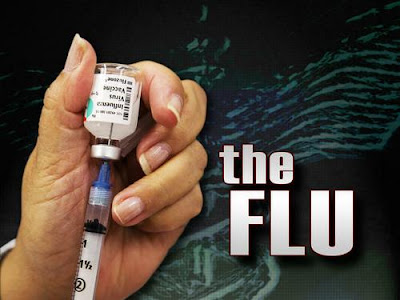Swine Flu Facts
What are the symptoms of swine flu in humans?
The symptoms of swine flu in people are expected to be similar to the symptoms of regular human seasonal influenza and include fever, lethargy, lack of appetite and coughing. Some people with swine flu also have reported runny nose, sore throat, nausea, vomiting and diarrhea.
Can people catch swine flu from eating pork?
No. Swine influenza viruses are not transmitted by food. You can not get swine influenza from eating pork or pork products. Eating properly handled and cooked pork and pork products is safe. Cooking pork to an internal temperature of 160°F kills the swine flu virus as it does other bacteria and viruses.
How does swine flu spread?
Influenza viruses can be directly transmitted from pigs to people and from people to pigs. Human infection with flu viruses from pigs are most likely to occur when people are in close proximity to infected pigs, such as in pig barns and livestock exhibits housing pigs at fairs. Human-to-human transmission of swine flu can also occur. This is thought to occur in the same way as seasonal flu occurs in people, which is mainly person-to-person transmission through coughing or sneezing of people infected with the influenza virus. People may become infected by touching something with flu viruses on it and then touching their mouth or nose.
What do we know about human-to-human spread of swine flu?
In September 1988, a previously healthy 32-year-old pregnant woman was hospitalized for pneumonia and died 8 days later. A swine H1N1 flu virus was detected. Four days before getting sick, the patient visited a county fair swine exhibition where there was widespread influenza-like illness among the swine.
In follow-up studies, 76% of swine exhibitors tested had antibody evidence of swine flu infection but no serious illnesses were detected among this group. Additional studies suggest that one to three health care personnel who had contact with the patient developed mild influenza-like illnesses with antibody evidence of swine flu infection.
How can human infections with swine influenza be diagnosed?What medications are available to treat swine flu infections in humans?
There are four different antiviral drugs that are licensed for use in the US for the treatment of influenza: amantadine, rimantadine, oseltamivir and zanamivir. While most swine influenza viruses have been susceptible to all four drugs, the most recent swine influenza viruses isolated from humans are resistant to amantadine and rimantadine. At this time, CDC recommends the use of oseltamivir or zanamivir for the treatment and/or prevention of infection with swine influenza viruses.
What other examples of swine flu outbreaks are there?
Probably the most well known is an outbreak of swine flu among soldiers in Fort Dix, New Jersey in 1976. The virus caused disease with x-ray evidence of pneumonia in at least 4 soldiers and 1 death; all of these patients had previously been healthy. The virus was transmitted to close contacts in a basic training environment, with limited transmission outside the basic training group. The virus is thought to have circulated for a month and disappeared. The source of the virus, the exact time of its introduction into Fort Dix, and factors limiting its spread and duration are unknown. The Fort Dix outbreak may have been caused by introduction of an animal virus into a stressed human population in close contact in crowded facilities during the winter. The swine influenza A virus collected from a Fort Dix soldier was named A/New Jersey/76 (Hsw1N1).
Is the H1N1 swine flu virus the same as human H1N1 viruses?How does swine flu spread among pigs?Â
Swine flu viruses are thought to be spread mostly through close contact among pigs and possibly from contaminated objects moving between infected and uninfected pigs. Herds with continuous swine flu infections and herds that are vaccinated against swine flu may have sporadic disease, or may show only mild or no symptoms of infection.
What are signs of swine flu in pigs?Â
Signs of swine flu in pigs can include sudden onset of fever, depression, coughing (barking), discharge from the nose or eyes, sneezing, breathing difficulties, eye redness or inflammation, and going off feed.
How common is swine flu among pigs?Â
H1N1 and H3N2 swine flu viruses are endemic among pig populations in the United States and something that the industry deals with routinely. Outbreaks among pigs normally occur in colder weather months (late fall and winter) and sometimes with the introduction of new pigs into susceptible herds. Studies have shown that the swine flu H1N1 is common throughout pig populations worldwide, with 25 percent of animals showing antibody evidence of infection. In the U.S. studies have shown that 30 percent of the pig population has antibody evidence of having had H1N1 infection. More specifically, 51 percent of pigs in the north-central U.S. have been shown to have antibody evidence of infection with swine H1N1. Human infections with swine flu H1N1 viruses are rare. There is currently no way to differentiate antibody produced in response to flu vaccination in pigs from antibody made in response to pig infections with swine H1N1 influenza.
While H1N1 swine viruses have been known to circulate among pig populations since at least 1930, H3N2 influenza viruses did not begin circulating among US pigs until 1998. The H3N2 viruses initially were introduced into the pig population from humans. The current swine flu H3N2 viruses are closely related to human H3N2 viruses.
Is there a vaccine for swine flu?
Vaccines are available to be given to pigs to prevent swine influenza. There is no vaccine to protect humans from swine flu. The seasonal influenza vaccine will likely help provide partial protection against swine H3N2, but not swine H1N1 viruses.




















